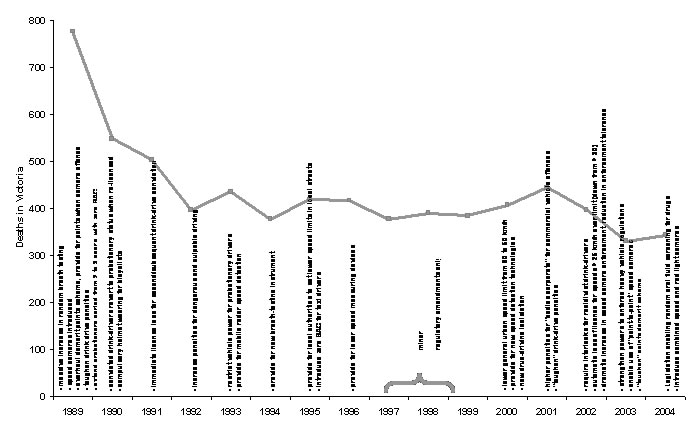U.S. Department of Transportation
Federal Highway Administration
1200 New Jersey Avenue, SE
Washington, DC 20590
202-366-4000
Victoria is Australia's second most populous State. Located in the southeastern corner of the mainland, it has a population close to 5 million with some 3.4 million registered vehicles and some 160,000 kilometers of public road. As in many other places, the number of deaths from road traffic crashes increased rapidly during the 1960s as motorization grew quickly. The number of deaths peaked at more than 1,000 in 1970, stimulating a public outcry and a rapid political response. That response, quickly followed by other States in Australia, was the introduction of compulsory seatbelt wearing. It also marked the beginnings of official recognition of traffic safety as a legitimate area for scientific inquiry and systematic action by government agencies. By the mid-1980s, the number of deaths had stabilized at around 700 per annum with no gains having been achieved for several years. In 1989 the number of deaths was more than 10 percent greater than the levels in 1988 and 1987. Again there was public outcry, and the Minister for Transport called in the heads of the key agencies and demanded action. The immediate catalyst for the meeting was the October 1989 spike in deaths, one of the highest monthly numbers of fatalities on record. The following agencies were involved:
This was a watershed event. For the first time, the key agencies were charged collectively with the task of reducing deaths on Victorian roads, compared with the traditional model in which each agency was responsible only for matters under its immediate control with minimal coordination of planning or implementation.
Victoria's first formal traffic safety strategy was formed in 1990. It examined the tools of engineering, enforcement, education, legislation, research, and the possible synergies of interagency coordination. A target was set of a 50 percent reduction in deaths. Neither the strategy nor the target was made public. Nevertheless, given the political imperative for action and the political instruction for interagency coordination, traffic safety intervention implementation was integrated for the first time.
Over the next 2 to 3 years, Victoria did the following:By 1992 the number of deaths had fallen to around 400, a drop of more than 40 percent against the levels of the mid-to-late 1980s and close to the (unpublicized) 50 percent target that had been set.
Encouraged by their success, the key agencies continued to build cooperative relationships, integrated traffic safety programs, and jointly formulated, under their own initiative, a new strategy for government to adopt. Meanwhile, the government had changed. The new government released the first public traffic safety strategy for Victoria (Safety First, Victoria's Road Safety Strategy 1995-2000), but it contained no targets and no accountability mechanisms. Its stated objective was simply to keep Victoria at the forefront of traffic safety performance both nationally and internationally. What this suggests is that the very large reduction in the average annual number of deaths from road crashes had removed the political imperative for further action, not that no further gains could be achieved. It may also have been that this particular government was less inclined to continue with tough legislative and enforcement initiatives.
(As an aside, some claim that most of Victoria's success has come from socialist-type rather than conservative-type governments. There is no real evidence to support this; innovative legislation has come from both. It would be more accurate to say that the government's willingness to act stems more from the personal beliefs of the ministers and premier of the day.)
The average annual number of deaths hovered around 400 for the rest of the decade. There was another apparent spike in 2001 with an increase of about 10 percent over the previous year. The government had changed again (in 1999) and the combination of public concern over the apparent upturn in the death toll, existence of a new government keen to make its mark, and appointment of a Minister for Transport with a strong personal commitment to reducing deaths and serious injuries from road crashes underpinned a new level of effort. This effort has reduced average annual deaths from about 400 to about 350, the lowest number since the 1940s.
Figure 3 plots road crash deaths in Victoria between 1989 and 2004 against a timescale of the major legislative, regulatory, and enforcement initiatives (derived from material supplied by VicRoads). The vehicle and infrastructure initiatives are not listed, so the reader should not infer any direct causal link.
Figure 3. Major regulatory and enforcement initiatives taken in Victoria from 1989 to 2004.
This brief history demonstrates the critical importance of both political saliency for the traffic safety issue and the vital importance of committed political leadership. The primacy of these two factors is hardly surprising given that traffic safety policy often involves tradeoff decisionmaking with mobility, development, and environmental objectives in transport.
| << Previous | Contents | Next >> |